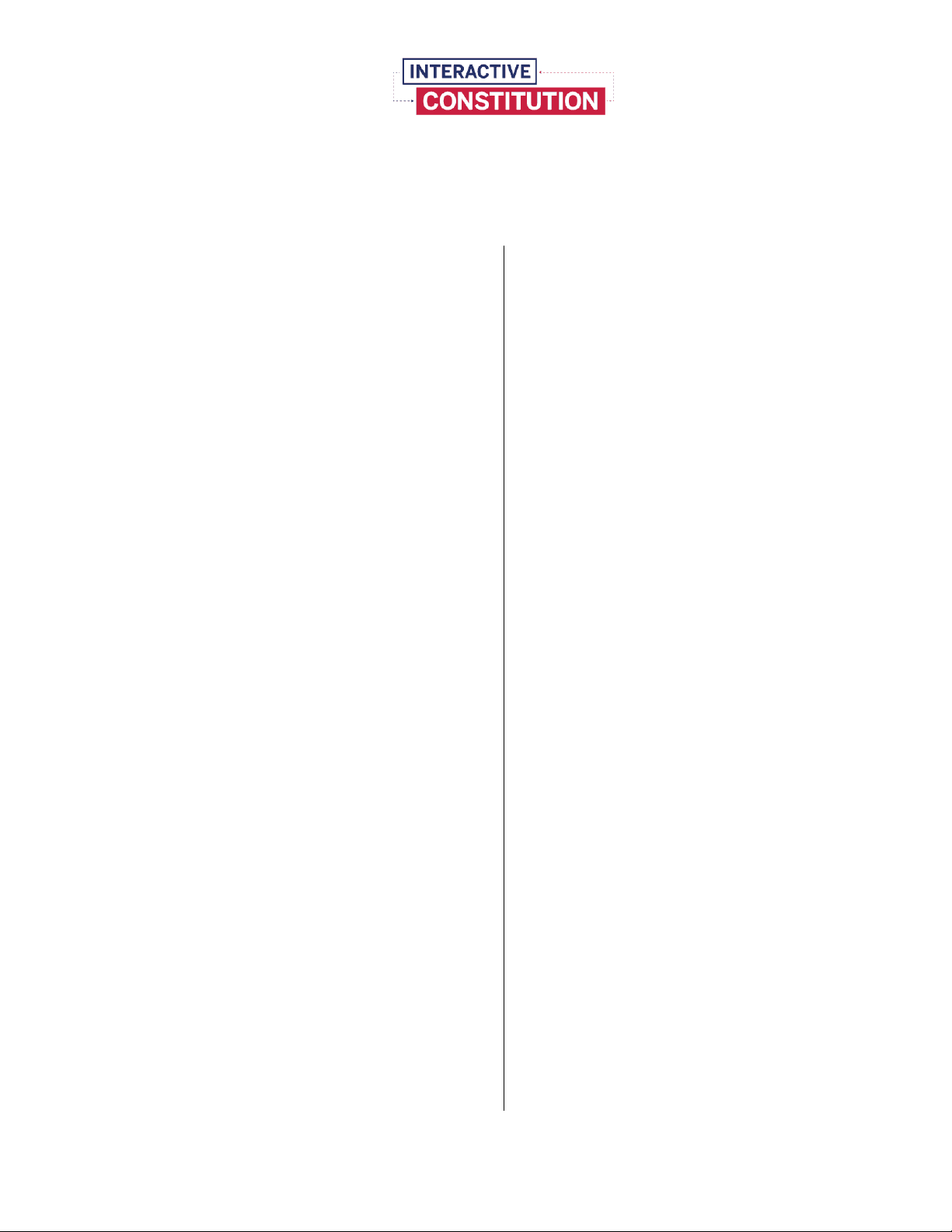

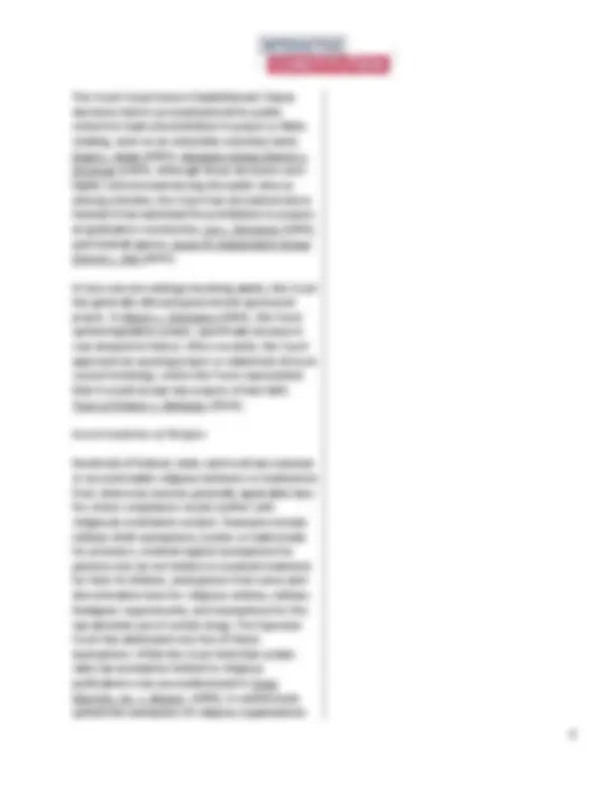
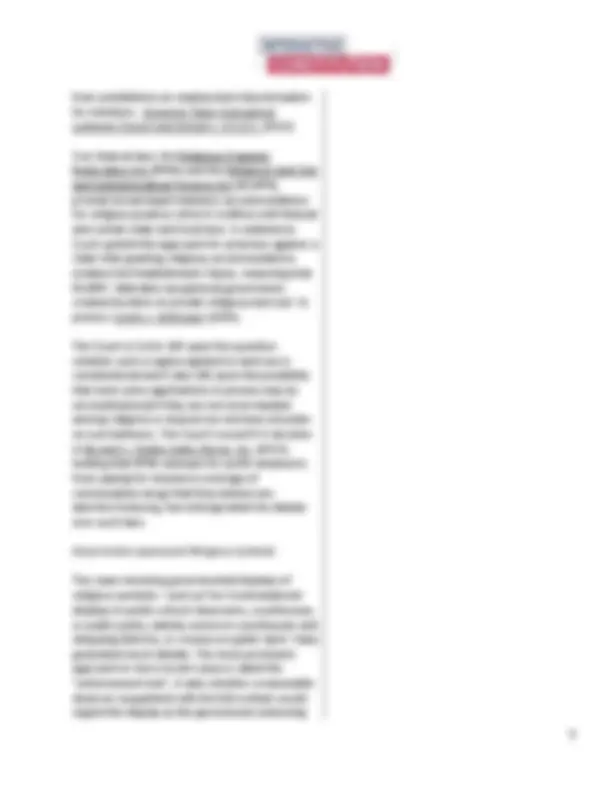
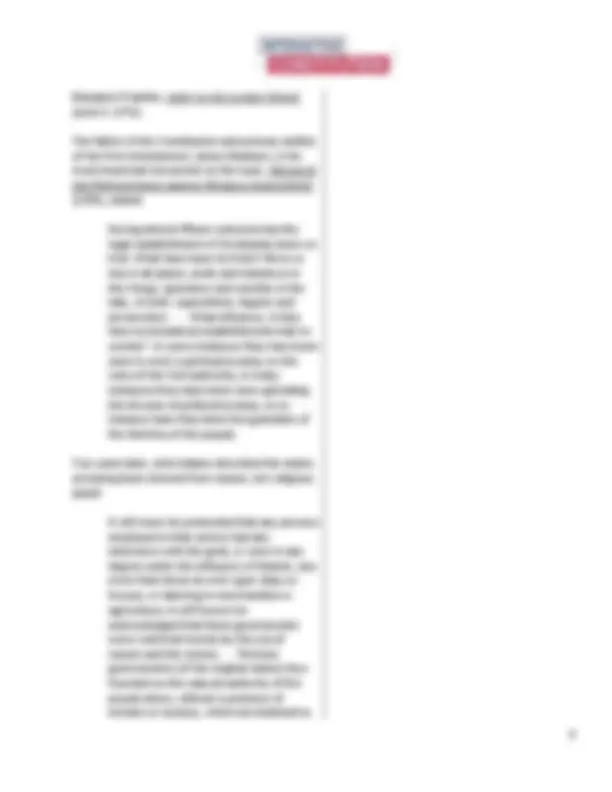
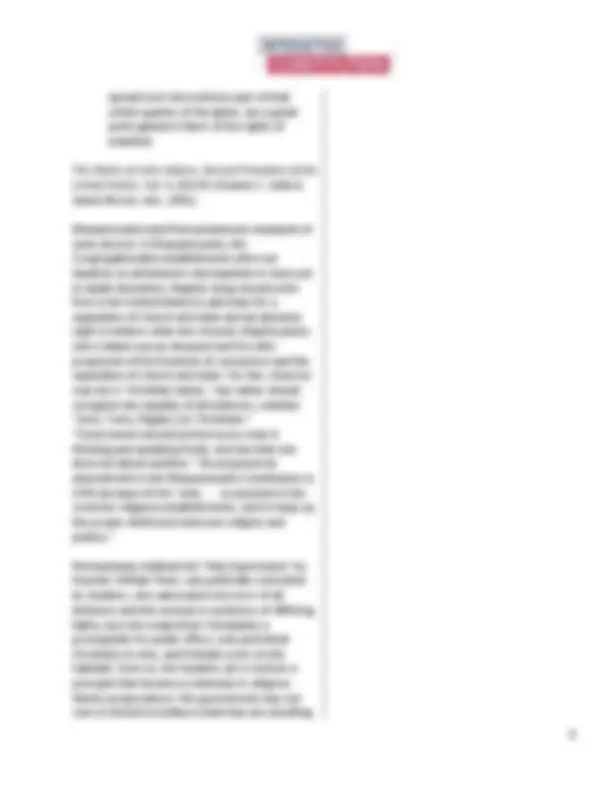
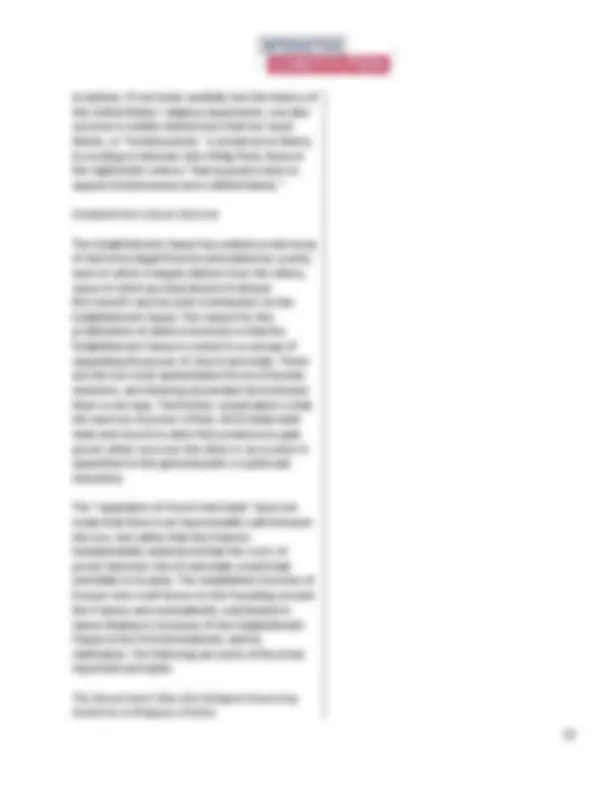
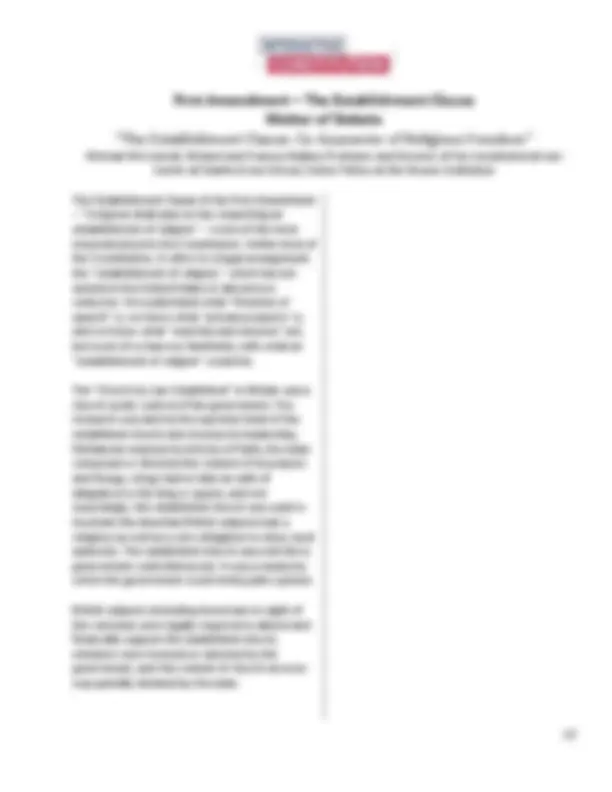
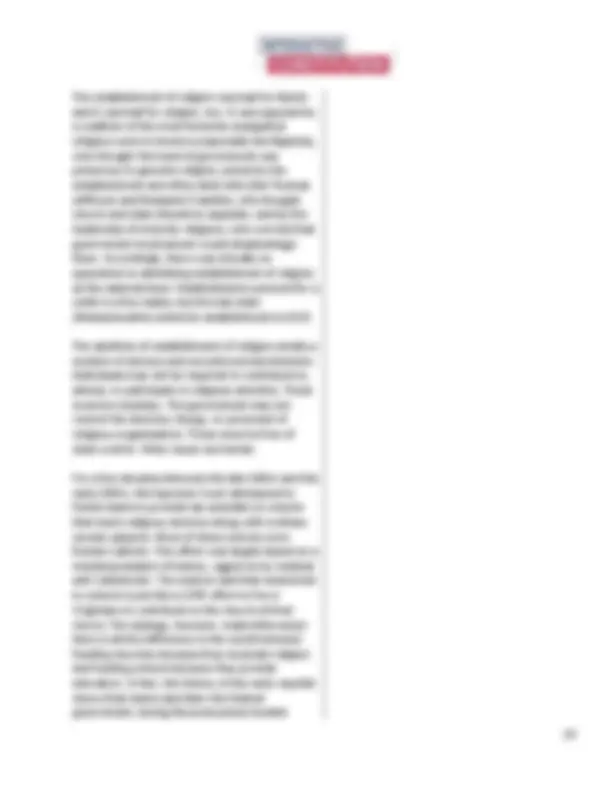



Study with the several resources on Docsity

Earn points by helping other students or get them with a premium plan


Prepare for your exams
Study with the several resources on Docsity

Earn points to download
Earn points by helping other students or get them with a premium plan
Community
Ask the community for help and clear up your study doubts
Discover the best universities in your country according to Docsity users
Free resources
Download our free guides on studying techniques, anxiety management strategies, and thesis advice from Docsity tutors
An analysis of the Establishment Clause of the First Amendment, focusing on the debates surrounding the relationship between religion and the state in American history. The authors discuss the historical context of religious diversity in the colonies, the interpretation of the Establishment Clause, and the implications for government funding of religious institutions, religious symbols, and religious accommodations. The document also includes perspectives from scholars Marci A. Hamilton and Michael McConnell on the importance of religious freedom and the potential dangers of religious tyranny.
What you will learn
Typology: Study notes
1 / 16

This page cannot be seen from the preview
Don't miss anything!










Marci A. Hamilton & Michael McConnell
America’s early settlers came from a variety of religious backgrounds: Puritans predominated in New England; Anglicans predominated in the South; Quakers and Lutherans flocked especially to Pennsylvania; Roman Catholics settled mostly in Maryland; Presbyterians were most numerous in the middle colonies; and there were Jewish congregations in five cities.
During colonial times, the Church of England was established by law in all of the southern colonies, while localized Puritan (or “Congregationalist”) establishments held sway in most New England states. In those colonies, clergy were appointed and disciplined by colonial authorities and colonists were required to pay religious taxes and (often) to attend church services. Dissenters were often punished for preaching without a license or refusing to pay taxes to a church they disagreed with. Delaware, New Jersey, Pennsylvania, Rhode Island, and much of New York had no established church.
After Independence, there was widespread agreement that there should be no nationally established church. The Establishment Clause of the First Amendment, principally authored by James Madison, reflects this consensus. The language of the Establishment Clause itself applies only to the federal government (“Congress shall pass no law respecting an establishment of religion”). All states disestablished religion by 1833, and in the 1940s the Supreme Court held that disestablishment applies to state governments through the Fourteenth Amendment.
Virtually all jurists agree that it would violate the Establishment Clause for the government to compel attendance or financial support of a religious institution as such, for the government to interfere with a religious organization’s selection of clergy or religious doctrine; for religious organizations or figures acting in a religious capacity to exercise governmental power; or for the government to extend benefits to some religious entities and not others without adequate secular justification. Beyond that, the meaning of the Amendment is often hotly contested, and Establishment cases in the Supreme Court often lead to 5-4 splits.
The Lemon Test
In 1971, the Supreme Court surveyed its previous Establishment Clause cases and identified three factors that identify whether or not a government practice violates the Establishment Clause: “First, the statute must have a secular legislative purpose; second, its principal or primary effect must be one that neither advances nor inhibits religion; finally, the statute must not foster an excessive entanglement with religion.” Lemon v. Kurtzman (1971). In the years since Lemon , the “test” has been much criticized and the Court often decides Establishment Clause cases without reference to it. Yet the Justices have not overruled the Lemon test, meaning the lower courts remain obliged to use it. In some specific areas of controversy, however, the Court has adopted specific, more targeted “tests” to replace Lemon.
The vast majority of Establishment Clause cases have fallen in four areas: monetary aid to religious education or other social welfare activities conducted by religious institutions; government- sponsored prayer; accommodation of religious dissenters from generally-applicable laws; and government owned or sponsored religious symbols.
The Court’s best-known Establishment Clause decisions held it unconstitutional for public schools to lead schoolchildren in prayer or Bible reading, even on an ostensibly voluntary basis. Engel v. Vitale (1962); Abington School District v. Schempp (1963). Although these decisions were highly controversial among the public (less so among scholars), the Court has not backed down. Instead it has extended the prohibition to prayers at graduation ceremonies, Lee v. Weisman (1992), and football games, Santa Fe Independent School District v. Doe (2000).
In less coercive settings involving adults, the Court has generally allowed government-sponsored prayer. In Marsh v. Chambers (1983), the Court upheld legislative prayer, specifically because it was steeped in history. More recently, the Court approved an opening prayer or statement at town council meetings, where the Town represented that it would accept any prayers of any faith. Town of Greece v. Galloway (2014).
Accommodation of Religion
Hundreds of federal, state, and local laws exempt or accommodate religious believers or institutions from otherwise neutral, generally-applicable laws for whom compliance would conflict with religiously motivated conduct. Examples include military draft exemptions, kosher or halal meals for prisoners, medical neglect exemptions for parents who do not believe in medical treatment for their ill children, exemptions from some anti- discrimination laws for religious entities, military headgear requirements, and exemptions for the sacramental use of certain drugs. The Supreme Court has addressed very few of these exemptions. While the Court held that a state sales tax exemption limited to religious publications was unconstitutional in Texas Monthly, Inc. v. Bullock (1989), it unanimously upheld the exemption of religious organizations
from prohibitions on employment discrimination for ministers. Hosanna-Tabor Evangelical Lutheran Church and School v. E.E.O.C. (2012).
Two federal laws, the Religious Freedom Restoration Act (RFRA) and the Religious Land Use and Institutionalized Persons Act (RLUIPA), provide broad-based statutory accommodations for religious practice when it conflicts with federal and certain state and local laws. A unanimous Court upheld this approach for prisoners against a claim that granting religious accommodations violates the Establishment Clause, reasoning that RLUIPA “alleviates exceptional government- created burdens on private religious exercise” in prisons. Cutter v. Wilkinson (2005).
The Court in Cutter left open the question whether such a regime applied to land use is constitutional and it also left open the possibility that even some applications in prisons may be unconstitutional if they are not even-handed among religions or impose too extreme a burden on non-believers. The Court’s recent 5-4 decision in Burwell v. Hobby Lobby Stores, Inc. (2014), holding that RFRA exempts for-profit employers from paying for insurance coverage of contraceptive drugs that they believe are abortion-inducing, has reinvigorated the debate over such laws.
Government-sponsored Religious Symbols
The cases involving governmental displays of religious symbols—such as Ten Commandment displays in public school classrooms, courthouses, or public parks; nativity scenes in courthouses and shopping districts; or crosses on public land—have generated much debate. The most prominent approach in more recent cases is called the “endorsement test”; it asks whether a reasonable observer acquainted with the full context would regard the display as the government endorsing
Marci A. Hamilton, CEO and Academic Director at CHILD USA; Fox Family Pavilion Distinguished Scholar in the Fox Leadership Program at the University of Pennsylvania
An accurate recounting of history is necessary to appreciate the need for disestablishment and a separation between church and state. The religiosity of the generation that framed the Constitution and the Bill of Rights (of which the First Amendment is the first as a result of historical accident, not the preference for religious liberty over any other right) has been overstated. In reality, many of the Framers and the most influential men of that generation rarely attended church, were often Deist rather than Christian, and had a healthy understanding of the potential for religious tyranny. This latter concern is to be expected as European history was awash with executions of religious heretics: Protestant, Catholic, Jewish, and Muslim. Three of the most influential men in the Framing era provide valuable insights into the mindset at the time: Benjamin Franklin, James Madison, and John Adams. Franklin saw a pattern:
If we look back into history for the character of the present sects in Christianity, we shall find few that have not in their turns been persecutors, and complainers of persecution. The primitive Christians thought persecution extremely wrong in the Pagans, but practiced it on one another. The first Protestants of the Church of England blamed persecution in the Romish Church, but practiced it upon the Puritans. These found it wrong in the Bishops, but fell into the same practice themselves both here [England] and in New England.
Benjamin Franklin, Letter to the London Packet (June 3, 1772).
The father of the Constitution and primary drafter of the First Amendment, James Madison, in his most important document on the topic, Memorial and Remonstrance against Religious Assessments (1785), stated:
During almost fifteen centuries has the legal establishment of Christianity been on trial. What have been its fruits? More or less in all places, pride and indolence in the Clergy, ignorance and servility in the laity, in both, superstition, bigotry and persecution.... What influence, in fact, have ecclesiastical establishments had on society? In some instances they have been seen to erect a spiritual tyranny on the ruins of the Civil authority; in many instances they have been seen upholding the thrones of political tyranny; in no instance have they been the guardians of the liberties of the people.
Two years later, John Adams described the states as having been derived from reason, not religious belief:
It will never be pretended that any persons employed in that service had any interviews with the gods, or were in any degree under the influence of Heaven, any more than those at work upon ships or houses, or laboring in merchandise or agriculture; it will forever be acknowledged that these governments were contrived merely by the use of reason and the senses... .Thirteen governments [of the original states] thus founded on the natural authority of the people alone, without a pretence of miracle or mystery, which are destined to
to believe. If one looks carefully into the history of the United States’ religious experiment, one also uncovers a widely-shared view that too much liberty, or “licentiousness,” is as bad as no liberty. According to historian John Philip Reid, those in the eighteenth century “had as great a duty to oppose licentiousness as to defend liberty.”
Establishment Clause Doctrine
The Establishment Clause has yielded a wide array of doctrines (legal theories articulated by courts), each of which is largely distinct from the others, some of which are described in Professor McConnell’s and my joint contribution on the Establishment Clause. The reason for this proliferation of distinct doctrines is that the Establishment Clause is rooted in a concept of separating the power of church and state. These are the two most authoritative forces of human existence, and drawing a boundary line between them is not easy. The further complication is that the exercise of power is fluid, which leads both state and church to alter their positions to gain power either one over the other or as a union in opposition to the general public or particular minorities.
The “separation of church and state” does not mean that there is an impermeable wall between the two, but rather that the Framers fundamentally understood that the union of power between church and state would lead inevitably to tyranny. The established churches of Europe were well-known to the Founding era and the Framers and undoubtedly contributed to James Madison’s inclusion of the Establishment Clause in the First Amendment, and its ratification. The following are some of the most important principles.
The Government May Not Delegate Governing Authority to Religious Entities
The Court has been sensitive to incipient establishments of religion. A Massachusetts law delegated authority to churches and schools to determine who could receive a liquor license within 500 feet of their buildings. The Supreme Court struck down the law, because it delegated to churches zoning power, which belongs to state and local government, not private entities. Larkin v. Grendel’s Den, Inc. (1982). According to the Court: The law “substitutes the unilateral and absolute power of a church for the reasoned decision making of a public legislative body…on issues with significant economic and political implications. The challenged statute thus enmeshes churches in the processes of government and creates the danger of [p]olitical fragmentation and divisiveness along religious lines.”
In another scenario, the Supreme Court rejected an attempt to define political boundaries solely according to religion. In Board of Education of Kiryas Joel Village School District v. Grumet (1994), the state of New York designated the neighborhood boundaries of Satmar Hasidim Orthodox Jews in Kiryas Joel Village as a public school district to itself. Thus, the boundary was determined solely by religious identity, in part because the community did not want their children to be exposed to children outside the faith. The Court invalidated the school district because political boundaries identified solely by reference to religion violate the Establishment Clause.
There Is No Such Thing as “Church Autonomy” Although There Is a Doctrine that Forbids the Courts from Determining What Religious Organizations Believe
In recent years, religious litigants have asserted a right to “church autonomy”—that churches should not be subject to governmental
Michael McConnell, Richard and Frances Mallery Professor and Director of the Constitutional Law Center at Stanford Law School; Senior Fellow at the Hoover Institution
The Establishment Clause of the First Amendment
The “Church by Law Established” in Britain was a church under control of the government. The monarch was (and is) the supreme head of the established church and chooses its leadership; Parliament enacted its Articles of Faith; the state composed or directed the content of its prayers and liturgy; clergy had to take an oath of allegiance to the king or queen; and not surprisingly, the established church was used to inculcate the idea that British subjects had a religious as well as a civic obligation to obey royal authority. The established church was a bit like a government-controlled press: it was a means by which the government could mold public opinion.
British subjects (including Americans in eight of the colonies) were legally required to attend and financially support the established church, ministers were licensed or selected by the government, and the content of church services was partially dictated by the state.
The establishment of religion was bad for liberty and it was bad for religion, too. It was opposed by a coalition of the most fervently evangelical religious sects in America (especially the Baptists), who thought the hand of government was poisonous to genuine religion, joined by the enlightenment and often deist elite (like Thomas Jefferson and Benjamin Franklin), who thought church and state should be separate, and by the leadership of minority religions, who worried that government involvement would disadvantage them. Accordingly, there was virtually no opposition to abolishing establishment of religion at the national level. Establishments survived for a while in a few states, but the last state (Massachusetts) ended its establishment in 1833.
The abolition of establishment of religion entails a number of obvious and uncontroversial elements. Individuals may not be required to contribute to, attend, or participate in religious activities. These must be voluntary. The government may not control the doctrine, liturgy, or personnel of religious organizations. These must be free of state control. Other issues are harder.
For a few decades between the late 1960s and the early 1990s, the Supreme Court attempted to forbid states to provide tax subsidies to schools that teach religious doctrine along with ordinary secular subjects. Most of these schools were Roman Catholic. This effort was largely based on a misinterpretation of history, egged on by residual anti-Catholicism. The Justices said that neutral aid to schools is just like a 1785 effort to force Virginians to contribute to the church of their choice. The analogy, however, made little sense: there is all the difference in the world between funding churches because they inculcate religion and funding schools because they provide education. In fact, the history of the early republic shows that states (and later the federal government, during Reconstruction) funded
understanding is captured in this statement by Justice William O. Douglas of the Supreme Court: this country “sponsor[s] an attitude on the part of government that shows no partiality to any one group and that lets each flourish according to the zeal of its adherents and the appeal of its dogma.” Zorach v. Clauson (1952).